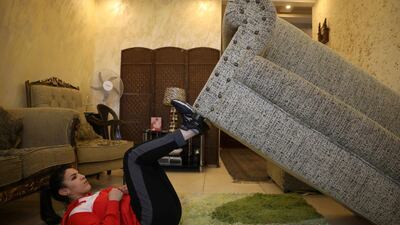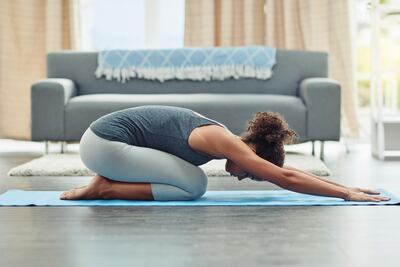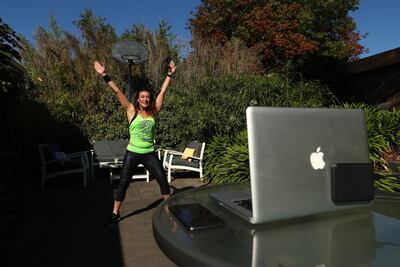It's a story that has been around since time immemorial: home gym equipment bought in a spurt of false enthusiasm, then left to gather dust in a forgotten corner of the house. Exercise bikes covered in clothes; dumbbells loitering in the darkest recesses of store rooms; and old-school ab crunchers searching for new homes on secondhand sites like Dubizzle.
But now, with visits to the gym and outdoor exercise options off the table, we are all having to bring our workouts into the home, whether we like it or not. That doesn’t mean you need tonnes of equipment, though.
“All you need is two square metres and a bit of will,” says Vladislav Farkas, personal trainer at Fitness First. “Anything else is just an added advantage.”
So before you rush off to order that treadmill and elliptical trainer, think about how much space you actually have, and what kind of exercise you plan to do. Do an honest "needs-analysis” of yourself. Here are some tips that might help.
A dedicated space
Whether you have an entire spare room waiting to be converted into a mini home gym, or are using a corner of your living room or balcony, choose a dedicated workout space and stick to it. Mark it out with some essentials – a mat, some towels, a water bottle and a Bluetooth speaker. It is always best to keep your gym equipment somewhere you can see it; if your dumbbells are stashed away under the bed, you will be far less inclined to actually use them.
Make it inspiring
Make your workout area as appealing as possible. Try to choose a spot with natural light, or make sure to introduce a good light source. An airy, well-ventilated spot is ideal and can be spruced up with motivational posters or even a plant. Make sure there is a clock or timer within your line of sight, so you can keep track of your workouts. And keep everything clean and tidy. A cramped, dim space will not inspire you to get active.
Lay down some cushioning
Avoid causing undue shock to your joints by exercising on a cushioned surface, whether it's a yoga mat or those puzzle foam blocks that are used in children’s play areas. While a mat is necessary for yoga, pilates and stretching, it will also support any floor exercises that you are doing, such as push ups and sit ups.
Stick to the basics
If you do want to invest in some exercise aids, stick to the basics: resistance bands for strength training and stretching; a kettlebell for weight lifting and to add resistance to body weight workouts; dumbbells for upper body workouts; and a medicine ball for strength training. Try to buy things that are not overly bulky and are easy to store. And remember, there are lots of items in the home that you can use as substitutes – you can do tricep dips using your (sturdiest) dining chairs or bicep curls using bottles of water and cans of soup. You can even substitute a resistance band with an old pair of tights.
Brush up on your body-weight exercises
If space is truly limited and a full-scale Zumba workout is out of the question, stick to body-weight exercises. They don't require much room, and are effective at building lean muscle and increasing strength levels. Seek out bodyweight workouts online – you may be surprised at the variety on offer.
Make sure you can see yourself
Form is particularly important if you are working out on your own, as you don’t want to cause any injuries. Try to exercise in front of a mirror, so you can keep an eye on your own form and correct yourself where necessary. Slow things down, keep an eye on yourself and do things properly.
Keep a workout log
Keep track of what exercises you are doing, what combinations you have planned, what routines you’d like to try out and what improvements you are making. This will go a long way in keeping you motivated.
WORLD'S%2010%20HIGHEST%20MOUNTAINS
%3Cp%3E1.%09Everest%0D%3Cbr%3E2.%09K2%0D%3Cbr%3E3.%09Kangchenjunga%0D%3Cbr%3E4.%09Lhotse%0D%3Cbr%3E5.%09Makalu%0D%3Cbr%3E6.%09Cho%20Oyu%0D%3Cbr%3E7.%09Dhaulagiri%0D%3Cbr%3E8.%09Manaslu%0D%3Cbr%3E9.%09Nanga%20Parbat%0D%3Cbr%3E10.%09Annapurna%0D%3C%2Fp%3E%0A
The specs
- Engine: 3.9-litre twin-turbo V8
- Power: 640hp
- Torque: 760nm
- On sale: 2026
- Price: Not announced yet
The specs
Engine: 2.0-litre 4cyl turbo
Power: 261hp at 5,500rpm
Torque: 405Nm at 1,750-3,500rpm
Transmission: 9-speed auto
Fuel consumption: 6.9L/100km
On sale: Now
Price: From Dh117,059
Top tips to avoid cyber fraud
Microsoft’s ‘hacker-in-chief’ David Weston, creator of the tech company’s Windows Red Team, advises simple steps to help people avoid falling victim to cyber fraud:
1. Always get the latest operating system on your smartphone or desktop, as it will have the latest innovations. An outdated OS can erode away all investments made in securing your device or system.
2. After installing the latest OS version, keep it patched; this means repairing system vulnerabilities which are discovered after the infrastructure components are released in the market. The vast majority of attacks are based on out of date components – there are missing patches.
3. Multi-factor authentication is required. Move away from passwords as fast as possible, particularly for anything financial. Cybercriminals are targeting money through compromising the users’ identity – his username and password. So, get on the next level of security using fingertips or facial recognition.
4. Move your personal as well as professional data to the cloud, which has advanced threat detection mechanisms and analytics to spot any attempt. Even if you are hit by some ransomware, the chances of restoring the stolen data are higher because everything is backed up.
5. Make the right hardware selection and always refresh it. We are in a time where a number of security improvement processes are reliant on new processors and chip sets that come with embedded security features. Buy a new personal computer with a trusted computing module that has fingerprint or biometric cameras as additional measures of protection.
THE BIO
Occupation: Specialised chief medical laboratory technologist
Age: 78
Favourite destination: Always Al Ain “Dar Al Zain”
Hobbies: his work - “ the thing which I am most passionate for and which occupied all my time in the morning and evening from 1963 to 2019”
Other hobbies: football
Favorite football club: Al Ain Sports Club
Two products to make at home
Toilet cleaner
1 cup baking soda
1 cup castile soap
10-20 drops of lemon essential oil (or another oil of your choice)
Method:
1. Mix the baking soda and castile soap until you get a nice consistency.
2. Add the essential oil to the mix.
Air Freshener
100ml water
5 drops of the essential oil of your choice (note: lavender is a nice one for this)
Method:
1. Add water and oil to spray bottle to store.
2. Shake well before use.
Coffee: black death or elixir of life?
It is among the greatest health debates of our time; splashed across newspapers with contradicting headlines - is coffee good for you or not?
Depending on what you read, it is either a cancer-causing, sleep-depriving, stomach ulcer-inducing black death or the secret to long life, cutting the chance of stroke, diabetes and cancer.
The latest research - a study of 8,412 people across the UK who each underwent an MRI heart scan - is intended to put to bed (caffeine allowing) conflicting reports of the pros and cons of consumption.
The study, funded by the British Heart Foundation, contradicted previous findings that it stiffens arteries, putting pressure on the heart and increasing the likelihood of a heart attack or stroke, leading to warnings to cut down.
Numerous studies have recognised the benefits of coffee in cutting oral and esophageal cancer, the risk of a stroke and cirrhosis of the liver.
The benefits are often linked to biologically active compounds including caffeine, flavonoids, lignans, and other polyphenols, which benefit the body. These and othetr coffee compounds regulate genes involved in DNA repair, have anti-inflammatory properties and are associated with lower risk of insulin resistance, which is linked to type-2 diabetes.
But as doctors warn, too much of anything is inadvisable. The British Heart Foundation found the heaviest coffee drinkers in the study were most likely to be men who smoked and drank alcohol regularly.
Excessive amounts of coffee also unsettle the stomach causing or contributing to stomach ulcers. It also stains the teeth over time, hampers absorption of minerals and vitamins like zinc and iron.
It also raises blood pressure, which is largely problematic for people with existing conditions.
So the heaviest drinkers of the black stuff - some in the study had up to 25 cups per day - may want to rein it in.
Rory Reynolds
Where to donate in the UAE
The Emirates Charity Portal
You can donate to several registered charities through a “donation catalogue”. The use of the donation is quite specific, such as buying a fan for a poor family in Niger for Dh130.
The General Authority of Islamic Affairs & Endowments
The site has an e-donation service accepting debit card, credit card or e-Dirham, an electronic payment tool developed by the Ministry of Finance and First Abu Dhabi Bank.
Al Noor Special Needs Centre
You can donate online or order Smiles n’ Stuff products handcrafted by Al Noor students. The centre publishes a wish list of extras needed, starting at Dh500.
Beit Al Khair Society
Beit Al Khair Society has the motto “From – and to – the UAE,” with donations going towards the neediest in the country. Its website has a list of physical donation sites, but people can also contribute money by SMS, bank transfer and through the hotline 800-22554.
Dar Al Ber Society
Dar Al Ber Society, which has charity projects in 39 countries, accept cash payments, money transfers or SMS donations. Its donation hotline is 800-79.
Dubai Cares
Dubai Cares provides several options for individuals and companies to donate, including online, through banks, at retail outlets, via phone and by purchasing Dubai Cares branded merchandise. It is currently running a campaign called Bookings 2030, which allows people to help change the future of six underprivileged children and young people.
Emirates Airline Foundation
Those who travel on Emirates have undoubtedly seen the little donation envelopes in the seat pockets. But the foundation also accepts donations online and in the form of Skywards Miles. Donated miles are used to sponsor travel for doctors, surgeons, engineers and other professionals volunteering on humanitarian missions around the world.
Emirates Red Crescent
On the Emirates Red Crescent website you can choose between 35 different purposes for your donation, such as providing food for fasters, supporting debtors and contributing to a refugee women fund. It also has a list of bank accounts for each donation type.
Gulf for Good
Gulf for Good raises funds for partner charity projects through challenges, like climbing Kilimanjaro and cycling through Thailand. This year’s projects are in partnership with Street Child Nepal, Larchfield Kids, the Foundation for African Empowerment and SOS Children's Villages. Since 2001, the organisation has raised more than $3.5 million (Dh12.8m) in support of over 50 children’s charities.
Noor Dubai Foundation
Sheikh Mohammed bin Rashid Al Maktoum launched the Noor Dubai Foundation a decade ago with the aim of eliminating all forms of preventable blindness globally. You can donate Dh50 to support mobile eye camps by texting the word “Noor” to 4565 (Etisalat) or 4849 (du).
Results
Stage three:
1. Stefan Bissegger (SUI) EF Education-EasyPost, in 9-43
2. Filippo Ganna (ITA) Ineos Grenadiers, at 7s
3. Tom Dumoulin (NED) Jumbo-Visma, at 14s
4. Tadej Pogacar (SLO) UAE-Team Emirates, at 18s
5. Joao Almeida (POR) UAE-Team Emirates, at 22s
6. Mikkel Bjerg (DEN) UAE-Team Emirates, at 24s
General Classification:
1. Stefan Bissegger (SUI) EF Education-EasyPost, in 9-13-02
2. Filippo Ganna (ITA) Ineos Grenadiers, at 7s
3. Jasper Philipsen (BEL) Alpecin Fenix, at 12s
4. Tom Dumoulin (NED) Jumbo-Visma, at 14s
5. Tadej Pogacar (SLO) UAE-Team Emirates, at 18s
6. Joao Almeida (POR) UAE-Team Emirates, at 22s
The%C2%A0specs%20
%3Cp%3E%0D%3Cstrong%3EEngine%3A%20%3C%2Fstrong%3E6-cylinder%2C%204.8-litre%20%0D%3Cbr%3E%3Cstrong%3ETransmission%3A%20%3C%2Fstrong%3E5-speed%20automatic%20and%20manual%0D%3Cbr%3E%3Cstrong%3EPower%3A%20%3C%2Fstrong%3E280%20brake%20horsepower%20%0D%3Cbr%3E%3Cstrong%3ETorque%3A%20%3C%2Fstrong%3E451Nm%20%0D%3Cbr%3E%3Cstrong%3EPrice%3A%20%3C%2Fstrong%3Efrom%20Dh153%2C00%0D%3Cbr%3E%3Cstrong%3EOn%20sale%3A%20%3C%2Fstrong%3Enow%3C%2Fp%3E%0A
COMPANY PROFILE
Founders: Alhaan Ahmed, Alyina Ahmed and Maximo Tettamanzi
Total funding: Self funded
Under 19 World Cup
Group A: India, Japan, New Zealand, Sri Lanka
Group B: Australia, England, Nigeria, West Indies
Group C: Bangladesh, Pakistan, Scotland, Zimbabwe
Group D: Afghanistan, Canada, South Africa, UAE
UAE fixtures
Saturday, January 18, v Canada
Wednesday, January 22, v Afghanistan
Saturday, January 25, v South Africa
MATCH INFO
Uefa Champions League final:
Who: Real Madrid v Liverpool
Where: NSC Olimpiyskiy Stadium, Kiev, Ukraine
When: Saturday, May 26, 10.45pm (UAE)
TV: Match on BeIN Sports
Expert input
If you had all the money in the world, what’s the one sneaker you would buy or create?
“There are a few shoes that have ‘grail’ status for me. But the one I have always wanted is the Nike x Patta x Parra Air Max 1 - Cherrywood. To get a pair in my size brand new is would cost me between Dh8,000 and Dh 10,000.” Jack Brett
“If I had all the money, I would approach Nike and ask them to do my own Air Force 1, that’s one of my dreams.” Yaseen Benchouche
“There’s nothing out there yet that I’d pay an insane amount for, but I’d love to create my own shoe with Tinker Hatfield and Jordan.” Joshua Cox
“I think I’d buy a defunct footwear brand; I’d like the challenge of reinterpreting a brand’s history and changing options.” Kris Balerite
“I’d stir up a creative collaboration with designers Martin Margiela of the mixed patchwork sneakers, and Yohji Yamamoto.” Hussain Moloobhoy
“If I had all the money in the world, I’d live somewhere where I’d never have to wear shoes again.” Raj Malhotra
ENGLAND SQUAD
Eoin Morgan (captain), Moeen Ali, Jonny Bairstow, Sam Billings, Jos Buttler, Tom Curran, Alex Hales, Liam Plunkett, Adil Rashid, Joe Root, Jason Roy, Ben Stokes, David Willey, Chris Woakes, Mark Wood





